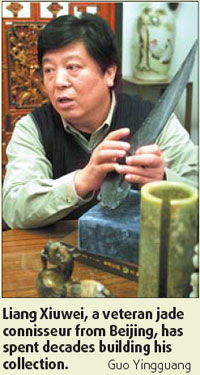Can you spot the difference?
The word "jade" oozes a sense of mystery. In Chinese, "jade" (yu) refers to a fine, beautiful semi-stone with a rich luster that is skillfully and delicately carved.
In Chinese culture, jade symbolizes noble virtues, perfection, constancy and immortality. For millennia, jade has been an intimate part of the lives of Chinese of all ranks and classes. Jade is found in mountains and riverbeds, and Chinese consider it to be "the essence of heaven and earth", the most valuable of all precious stones.
"The limited jade resources and growing demand in the market have driven up the prices. The gemstone has almost become the 'crazy stone'," says Xu Shugui, a cultural heritage appraiser.
"The high profits have tempted some craftsmen to make fakes which are widespread in small-scale, low-end jade markets across the country," Xu says.

Experts in jade collection, testing and appraisal have offered some useful tips for those interested in collecting jade items.
Liang Xiuwei, a veteran jade connoisseur in Beijing, suggests that a potential investor should be able to spot the differences in patterns, motifs, and jade artisanship, before spending any money.
"A good jade collector should become a researcher. If you only care about the changing prices, you will never be a successful collector because profits will blind you to imitations," says Liang, who has written several books about the precious gemstone.
Chen Wei, a jade dealer in Panjiayuan Antique Market of Beijing, says that an experienced jade buyer should become acquainted with real, quality jade works. "Visit jade exhibitions and auction previews. Even if you can't get your hands on them, watch them closely and carefully. You will soon be able to determine what is real and what is fake," Chen says.
"Always consult with experts. But don't always follow what they tell you. Their conclusions should only be reference points," says Liu Xinliang, a jade collector for 10 years and editor-in-chief of China Art Market magazine.
"Sometimes, nobody can be sure if a certain jade piece is authentic, especially when it comes to figuring out which era the jade has come from. So, sharpen your mind and eyes, and trust your own judgment."
It is useful to learn more about how fake and imitation jade is made. However, manufacturers are also improving their techniques, warns Gao Shan, an expert with the Beijing Dida Gem Testing Center.
"It's like the viruses that damage computers. The anti-virus software makers are always following the trends created by the hackers and programmers," says Gao.
"The simplest method to reduce your risks in jade collection is to buy only at big shops which value their credibility, and always ask for a certificate from a State-authorized gem testing agency," Gao says.
(China Daily 11/08/2007 page18)














